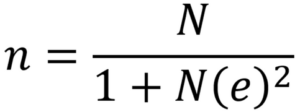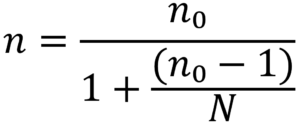

Sample Size Calculations: A Complete Guide
Are you looking for a complete and an inclusive answer for your queries related to sample size size calculations? Yes? Great.
In this post you are going to get a complete guide including answers of frequent and most common queries about the sample size calculations. What is a sample size? What are different ways to calculate sample size? And a lot more about the sample size calculator, determining sample size, sample size formula etc.
Thus, do not miss reading the article till the end and get all your doubts clear about sample size calculation in the most appropriate way. Along with that, get all the other interesting information about the relevant topics that are waiting for you to read. Thus, do not skip reading them.
What Is Sample Size?
The phrase “sample size” is frequently used in market research to describe the number of survey respondents. Because it’s a small group intended to reflect a wider population, or target audience, it’s called a “sample.”
For example, you might be inquisitive about how Americans feel about a specific issue. Since it is impossible to poll every member of the population, a sample of the population that is representative of the entire population is gathered and polled in order to understand the sentiment of the wider public.
Fynzo Survey: Unlock unlimited surveys, gather without constraints, and enjoy most features free forever.
Create a free survey to know your respondents.
Why Calculating Sample Size Is Useful?
Be that as it may, since we can not talk for each long-distance runner or be a certain runner or be certain of how Weetabix influences the execution of long-distance runners, there will continuously be a few edges of mistakes within the ponder.
In other words, a more precise picture of how devouring Weetabix can influence long-distance runners’ execution.
So what information is required to determine the minimum sample size required for a research project?
How To Find A Sample Size?
Sample size calculations are extremely different from finding the sample size. The sample size calculations are only possible when you are having a sample in your hand. As you know what a sample size is, you think about finding the sample size from the universe or population.
There is a parcel of strategies for finding the test measure . Here are the very simple and exclusive steps of finding the sample size that can give you a brief and inclusive idea of finding a sample size:
- For tiny population, a census can be taken to determine the sample size. For instance, you might only have time to survey 1,000 students at a small private university in one day whereas you may need to survey 10,000 students at a public university to cover the adequate sample size.
- You can utilize the sample size from a similar study done in the past. Your particular type of research has probably already been done. One drawback is that since you’ll be depending on someone else to determine the sample size accurately, any mistakes they made in their calculations will be reflected in your research.
- You can use a table according to your purpose and nature of the study or research to determine your sample size.
- You can also use of a sample size estimator. Various online calculators, some basic and some more advanced and specialized, are available for this very purpose.
- Similar to the previous step, you can employ a formula. Depending on the information you have (or don’t have) about your population, there are a various formulae for you to employ.
Thus, employing the above steps with a perfectly suitable method of sampling can make your research and study successful and extremely easy to conduct.
After the successful search of a most suitable and appropriate sample, calculations are crucial. We are now going to acquaint you with the most suitable methods of sample size calculations that you can use under your study.

How To Calculate The Sample Size?
There are a lot of ways to calculate a sample size but the important part is how to make sample size calculations. Here we are going to tell the most effective and easy approaches or methods to make the sample size calculations.
Yamane’s Formula
It is an extremely effective and easy formula for making the sample size calculations. Here is the formula:

where,
e = level of precision, the population size is N.
Z-Score
To know this method, acquainting with some important terms is important. They are:
- Confidence Level
Your level of confidence in this outcome is indicated by your confidence level. If multiple samples were drawn, the likelihood that various samples would yield this result is expressed as a percentage. The 95 percent confidence level indicates that findings would fall within this -/+ interval confidence interval 19 out of every 20 times. The most typical level of confidence is 95 percent.
You’ll state merely that 95% certain that the honest to goodness rate of the populace that will “purchase a blessing for mother” is between 79.25% and 84.75% once you combine the certainty level and the certainty interim.
Wider confidence intervals boost the likelihood that the real result falls inside the given range. The lesser sample sizes are the cause of these broader confidence intervals. When a choice worth millions of dollars is at stake and the costs of an error are exceedingly substantial, the confidence interval should be maintained as small as possible.
- Population Size
The population size of the group you’re seeking to examine is the total number of members. The population of the United Kingdom would be slightly more than 68 million if a random sample were to be taken from the entire country.
- Standard Deviation
This alludes to the degree to which personal reactions will veer from the cruel. Scores will be closely grouped around the mean with little fluctuation if the standard deviation is low. Reactions will be more scattered when plotted on a chart on the off chance that the standard deviation is bigger. 0.5 is respected as a “great” standard deviation to set up to guarantee a test measure that precisely speaks to the populace. Standard deviation is communicated as a decimal.
As you are well aware of the terms that are relevant in using this formula, let us move forward to know the formula.
All you need to do is to simply put, a z-score is a numerical representation of the desired level of confidence. Your score’s standard deviation from the mean is indicated.
The most ordinary rates are 90, 95 and 99 percent.
z = (x – μ) / σ
The z-score is fair, the crude score less the populace cruel and partitioned by the populace standard deviation, as the calculation illustrates.
Once you have your z-score, you can complete the sample size calculation, which is as follows:

Cochran’s Sample Size Formula
Given a craved level of accuracy, a wanted level of certainty, and an evaluated division of the quality display within the populace, you’ll utilize the Cochran equation to decide the ideal test measure.
Cochran’s formula is thought to be particularly useful in scenarios with big populations. In the event that the population as a entirety is moderately little, there’s an “adjustment” which will be utilized to lower the number given by Cochran’s equation. A test of any given measure offers more data to approximately a littler populace than a bigger one.
This is the Cochran formula:

where:
p is the (estimated) fraction of the population that possesses the property in question, and q is equal to 1 – p. E stands for the required level of precision
A Z-table contains the z-value.
Fynzo Survey: No limits on surveys, responses, and most features free for eternity.
Calculate the sample size and conduct a survey now.
FAQs
What Is The Best Formula For Finding Sample Size?
Though the method becomes the best if it makes your study easy and comfortable to conduct, we can say that Slovin’s formula is the best if we talk generally.
Taking after may be a portrayal of the Slovin’s Equation: Within the equation, n is the test measure, N is the populace measure, and e is the researcher-determined edge of errors or mistakes.
What Is Necessary For Sample Size?
The answer is 100.
The majority of statisticians concur that a sample size of 100 is necessary to obtain any form of significant results. If your population is less than 100, you should definitely survey every single person.
Why Is 30 The Minimum Sample Size?
It takes at least 30 observations to do statistical analyses that are meaningful. This can be interpreted in a variety of ways, with the most fallacious one being that your confidence interval can be trusted with a sample size of 30.
What Types Of Sampling Techniques Are There?
Probability and non-probability sampling are the two essential types of sampling methods. In probability sampling, commonly referred to as random sampling, randomization is employed to pick samples rather than consciously choosing.
What Is Snowball Sampling?
In the recruitment method known as “snowball sampling,” volunteers are invited to help find additional potential subjects.
Final Word
We hope that the above information was useful to you. Keep reading our posts to get such informative as well as interesting information.








